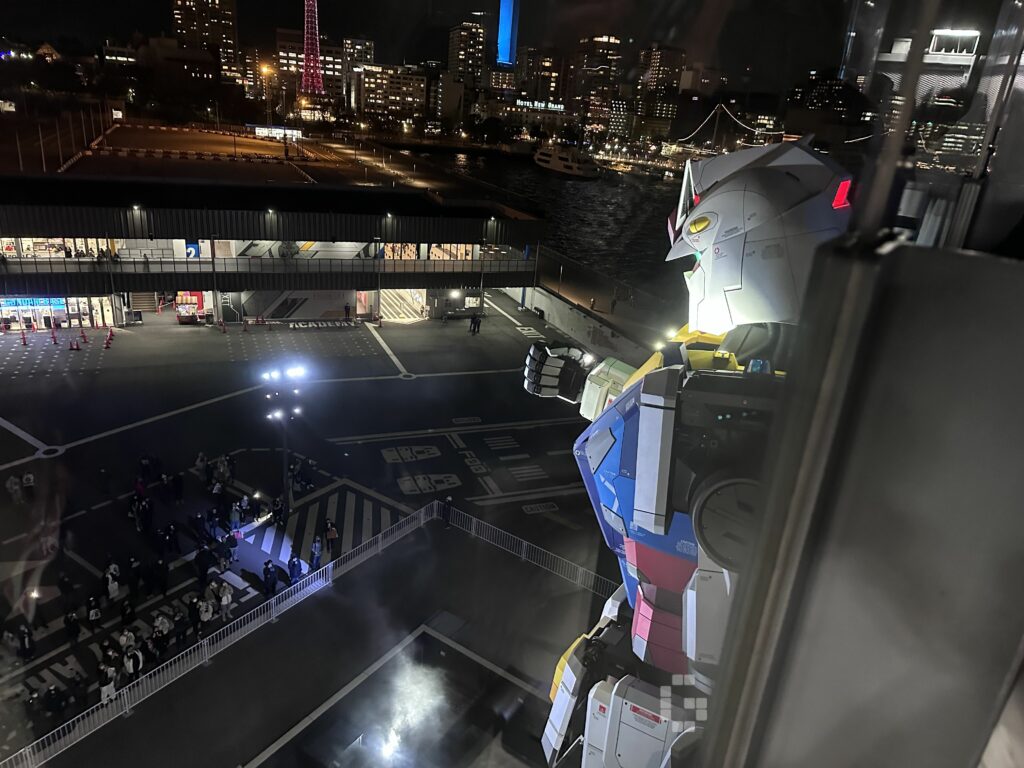Gundam is huge, there’s no denying it. For as much as modern anime fandom has devolved into a dick measuring contest about whose bankai-quirk-domain-expansion is the best, there exists that superclass of anime that are just actual cultural milestones.

The Yokohama Gundam is something of a bizarre cultural icon. A life-sized rendition of the Gundam that started it all, it’s also the most advanced of the multiple statues, sporting walking and more. Despite this, it was a victim of just horrible timing- the exhibit launched at the height of the pandemic, and it was announced that what walks on two legs in 2020 wouldn’t be doing so for much longer.
Still, Japan’s restrictions on tourism during the pandemic saved the White Devil of the Federation- Sunrise would announce an extension on the mobile suit’s lifespan, letting people outside of Japan finally bear witness to it outside of shaky Facebook video footage.
Now, I’ve had the luxury of visiting Japan quite a bit in the past year. Each time, though, I never managed to get enough wriggle room to actually head to Yokohama to visit it. In my mind, the train out to Yokohama was akin to practically leaving a whole state, and I’d have to make a special whole-day trip just to see it.
My most recent venture to Japan came at just the right time- as a friend pointed out, The Gundam’s new lease on life was due to come to an end in March. I’d resolved to make time to see it, once again under the worry that it would be a whole-day affair. As one does on holidays, I’d meticulously curated my time slots, making sure that travel was as efficient as possible, hitting as many hotspots without backtracking like Sam Porter Bridges but with money set aside for scale figures.
With one appointment ending earlier than expected, I was suddenly presented with a new dilemma: waffle around or take the surprisingly shorter than anticipated train out to Yokohama and see this mechanical majesty a day earlier than intended. The answer was obvious: I was going to Yokohama today, braving crowds and delays and the cold winter air.
The Gundam Factory Yokohama Experience
Unlike the Odaiba Gundam at Diver City, the Yokohama Gundam Factory is a paid exhibit. There’s a reasonable admission fee, letting you watch the towering mecha from the ground level. However, for the more financially robust, there’s also a much pricier viewing dock.
This here was when I realized the emotional crux of the whole trip: unlike my very first trip to Japan where the Diver City Gundam filled me with hope, Yokohama’s structure instead filled me with a kind of grief. I was excited to see one of my favorite mecha (until Sunrise builds a life-sized Big O), sure, but there was that specter hanging overhead- this was to be the last time I’d see it, even though it was also the first.
Personally, I think its natural to live a life with a few regrets. To miss what could have been is as natural as bed head, and everyone who tells you they have absolutely no regrets is probably coping with their own repressions and denial. But still, one less regret is always nice, especially when all it takes is a little less take-out after paying next month’s credit card bill.
With that, I cleared all doubt in my head- I was going to get the viewing dock tickets, and I’d also stay for the next show as well- to catch from the ground seats.
I should point out if you’re planning to go to Yokohama and don’t have the luxury of time to wait two whole hours or spend 5k yen per person on getting your whole family up to the docking station, that experience is totally missable. The show is very much meant to be watched from the ground level, since the viewing platform is instead to the left of the Gundam.

Its value instead lies in the fantasy. We’ve all seen those shots from every mecha anime, where the crew watch as a giant robot whose head is bigger than their entire being walks on by. You get to travel between two floors, getting an up-close view of the Gundam itself, and at each phase of the performance different floors become more valuable. As a kid who grew up building the model kits, it’s an absolutely surreal experience to suddenly find yourself in the very kind of setting mecha anime are based off of.
At the end of the show, the Gundam is deactivated, and mechanical arms pull it back into its hangar bay. Funny enough, it was a kid in the crowd that brought this whole angle to my attention.
“Sayonara, Gundam”, she said.
Considering it was about 4 degrees (so says my weather app, which probably didn’t account for being 20 metres in the air and by the sea), there was a quiet calm in the few minutes between the end of the show and when we were escorted back down. Seeing the giant robot that was just bursting with life quietly shuffled back into the hangar felt weirdly macabre, and I don’t think I’ll ever put a finger to why.

As per my plan, I’d stayed for the ground-level show, too. What’s to say about it? Seeing the closest thing to a real life mecha walking forwards while everyone talks about running tests and the like is a thrilling experience, especially when it mixes in with great music choices like the soundtrack to Gundam Unicorn. A particular moment in the show features the test pilot hearing a noise coming from far away, and the way the Gundam moves feels so realistic that for just a split second, I actually wondered if there was something going on. Every second of the show was perfect, and I was almost moved to tears.
It’s hard to describe just what makes you see something that gorgeous and decide that grief is your primary feeling. Like I said at the top of this, the Yokohama Gundam is easily the most advanced of the multiple 1:1 scale Gundams built. It’s not a statue with moving parts like the Unicorn or Nu Gundams. The advanced nature of the project represents the kind of optimism that the Gundam series is secretly built on- it’s about excitement and showing even crowds who’d gotten used to 1:1 scale mecha something that they’d never seen before.
Grieving A Giant Robot

One day, someone much smarter than me might look into this topic of creative grief- the idea that you can shine brighter than everything around you and still be caught unaware is something that weighs on my mind a lot. To me, seeing one of the most beautiful Gundam installations ever made only to know it would be gone in a couple of weeks was harrowing. Considering how much it must need to be maintained, it makes sense for the bottom line to drop it if you’re trying to cut costs and people are more than happy to stick with the usuaI static statues.
As someone who got put through the grief ringer in recent years, it’s hard to not see these feelings as smaller scale versions of how I felt in all those hospital rooms, or lazy days suddenly ripped apart by horrid phone calls. The pain of losing a cool statue will never echo the pain of losing real people, but that doesn’t mean it can’t hit your buttons to make you feel that all over again.

In a strange way, the Gundam felt like a silly manifestation of that. Out there on the cold Yokohama Harbor, I watched a giant robot puppet pretend to be possessed by the ghost of a dead guy and strike a few poses, and I wept. Not because the show itself was a tragedy, but because of just how much effort it had taken me to get here. Three trips, and it was only the threat of having it taken away from me forever that spurred me to actually come down to visit.
When I visit Odaiba Gundam, I use it as a platform to reflect on myself- my first time visiting it I was a university student, my second time was as a full-fledged journalist squeezing time in amid the hectic crossfire of Tokyo Game Show. Yet face-to-face with the Yokohama Gundam all I feel instead is mourning. For as many people have Gundam tattoos or shelves upon shelves of Gunpla, the Yokohama Gundam will still put on its last show, in a couple of weeks. And life will go on after it, too.

This isn’t some promotion to come to Japan and blow all your money in hopes of keeping the exhibit alive- considering the short timespan I doubt that’d make a difference. Instead it’s just a reminder of how good anime fans currently have it- the first Gundam model kits didn’t even have color separation, let alone giant 1:1 moving statues of them.
It’s easy to fall into despair knowing everything’s just sand slipping between your fingers, but instead it should be motivating. Go live in the now. Take the steps you need to be responsible, yes, but don’t be afraid to occasionally actually get out there and see something truly beautiful. Because even when it goes, you’ll still remember how beautiful that night on the harbor was.
P.S: In the time it’s taken me to actually edit the article it looks like Bandai has announced another year’s extension on our dear Yokohama Gundam. Unfortunately, this brings us to another of life’s important lessons: You can only take credit for the ideas you hit publish on.













![[EXCLUSIVE] Creative Masterminds from Gearbox Software Reveal What Makes Borderlands 4 Worth the Wait](https://cdn.gamerbraves.com/2025/07/Borderlands-4-at-Bilibili-World-2025_Interview_FI-360x180.jpg)




![[ASIA EXCLUSIVE] Bringing Back a Classic: Inside the Making of FINAL FANTASY TACTICS – The Ivalice Chronicles](https://cdn.gamerbraves.com/2025/06/FFT-Ivalice-Chronicles_Interview_FI2-360x180.jpg)












